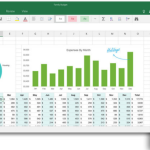You sit in your bedroom, phone in hand, scrolling through social media while you should be studying for your science test tomorrow. You know you should focus, but you can’t help but wonder how anyone ever managed to get through school without the internet. After all, there’s so much information at your fingertips – why bother memorizing it when you can just look it up?
As it turns out, students have been using technology to study science since the internet was invented. Technology has played a vital role in furthering our understanding of the scientific world around us. In this article, we’ll explore 6 different technologies used by students to study science.
1. Virtual Reality
You might be wondering how virtual reality (VR) technology might be used in scientific studies as a student. The truth is, that VR can be a great tool for studying science since it allows you to immerse yourself in an environment and experience things firsthand. For example, you could use VR to explore different planets or solar systems or examine the human body’s inner workings. You could even use VR to conduct experiments since you would completely control the variables. In short, VR offers a unique and powerful way for students to engage with science.
2. Digital Learning
You love science. You’re always asking questions about the world around you and how things work. But sometimes, it’s hard to understand all the concepts in your science textbook. That’s where digital learning classrooms and multimedia consoles can help. With interactive games, simulations, and educational videos, these tools can make learning science fun and engaging. You can examine things as often as you need until you are confident in your grasp because they can be employed at your own speed.
3. Data Collection
Data collection can help students and educators identify trends and patterns. This data can be utilized to better customize instruction to the needs of students. For example, suppose data shows that many students struggle with certain scientific concepts. In that case, the teacher can adjust the lesson plans accordingly. A data-collection software solution is typically used to assess student growth over time. This information is essential for understanding how well students respond to instruction and make necessary changes along the way. It would be difficult to assess whether children are making progress or if they require further science support without data. Finally, data can help educators plan for the future. By looking at past performance, educators can make predictions about whether students will have a future in the field of science.
4. Social Media
You might not think that social media and science have much in common. After all, one is about networking and sharing information, while the other is about data and experimentation. However, social media can be a valuable tool for students hoping to learn more about science. For example, Twitter can be used to follow scientists and science writers, providing users with news and information about the latest discoveries. In addition, Facebook groups and forums can provide a space for students to discuss difficult concepts and share resources. And of course, YouTube is full of educational videos that can help explain complex scientific ideas.
5. Artificial Intelligence and Machine learning
As a student, you’re always looking for ways to get ahead. Whether it’s finding new methods of studying or utilizing technology to make learning science easier, there’s always room for improvement. Recent advancements in machine learning and artificial intelligence can help students learn science more effectively. These technologies can help you make the most of your study time by providing targeted feedback and personalized recommendations. In addition, they can also provide you with instant feedback on scientific quizzes and assignments, helping you to identify areas in which you need improvement. With so much potential, it’s no wonder that more and more students are turning to machine learning and artificial intelligence for help with their studies.
6. Podcasts
You love listening to podcasts. In fact, you can’t go a day without listening to at least one episode of your favorite show. You may not realize that podcasts can also be a great way to learn about science. That’s right. Whether you’re trying to understand the latest breakthrough in quantum mechanics or simply want to brush up on your knowledge of basic chemistry, podcasts can help you learn and excel in science.

One of the most appealing features of podcasts is the ability to listen to them from any location and at any time. Whether commuting to school or taking a break between classes, you can always find time to listen to a podcast. Another perk of podcasts is that they provide a more participatory and engaging learning experience than reading a textbook does. Many science podcasts are hosted by experts who are passionate about their work, and this passion is often infectious.
The six technologies mentioned above have greatly helped students learn more about science. Therefore, students of all ages are better equipped to comprehend the scientific world around them. The future of science appears brighter than ever, thanks to the ever-evolving world of technology.















